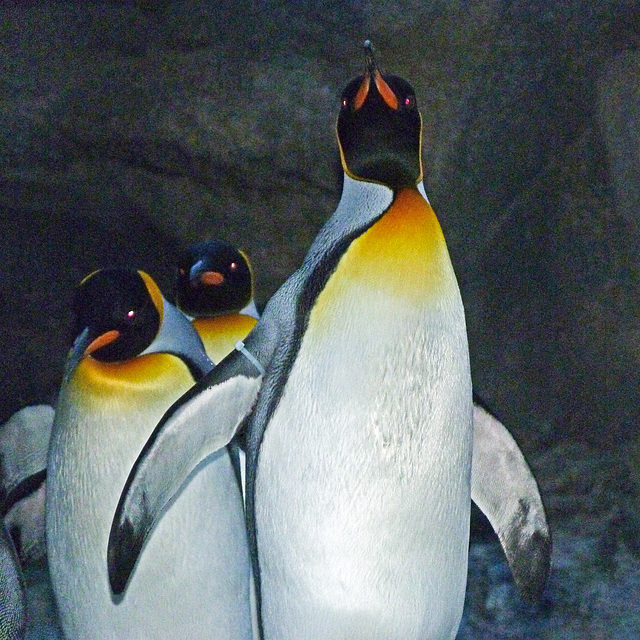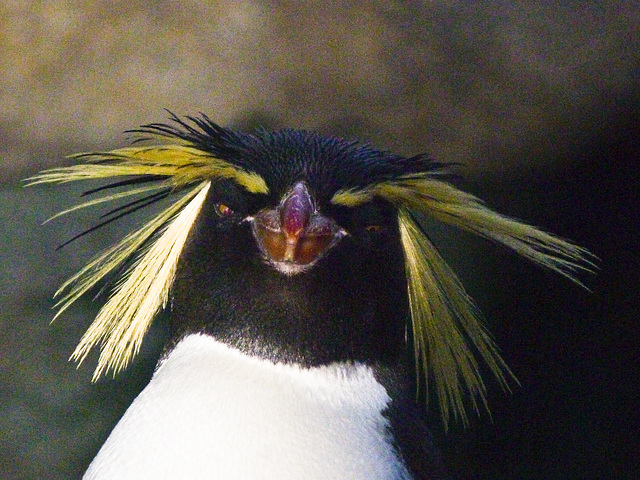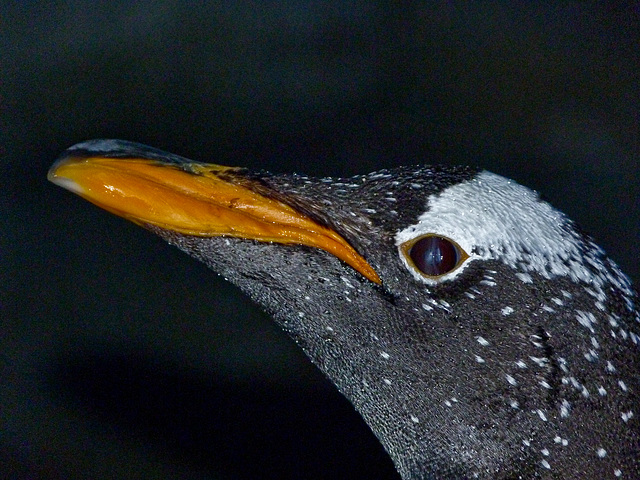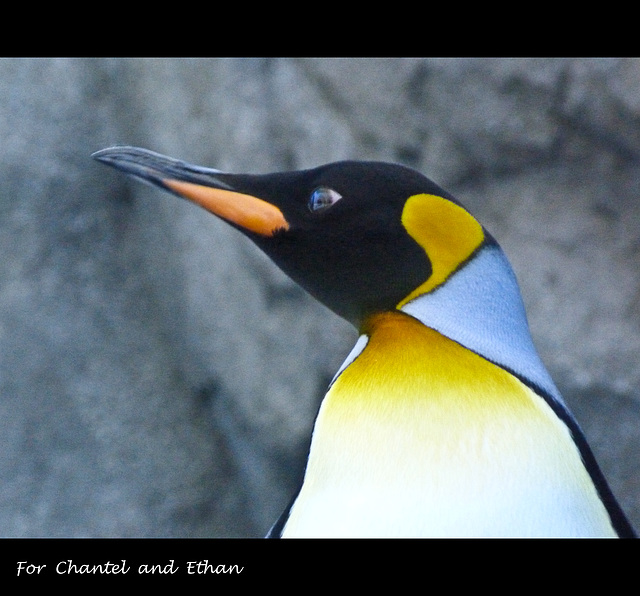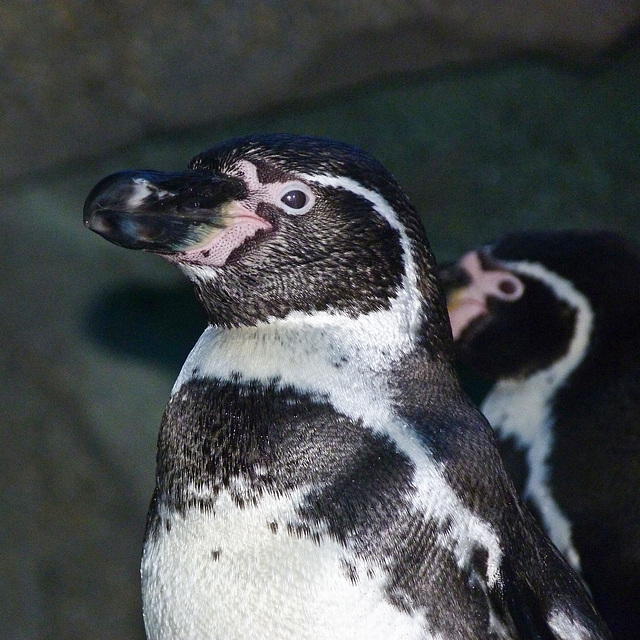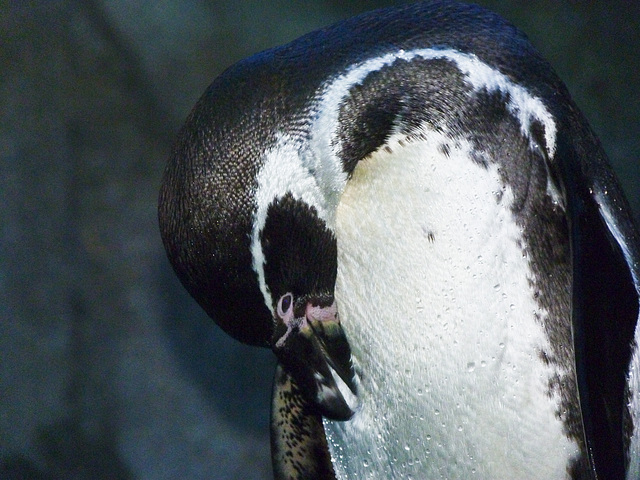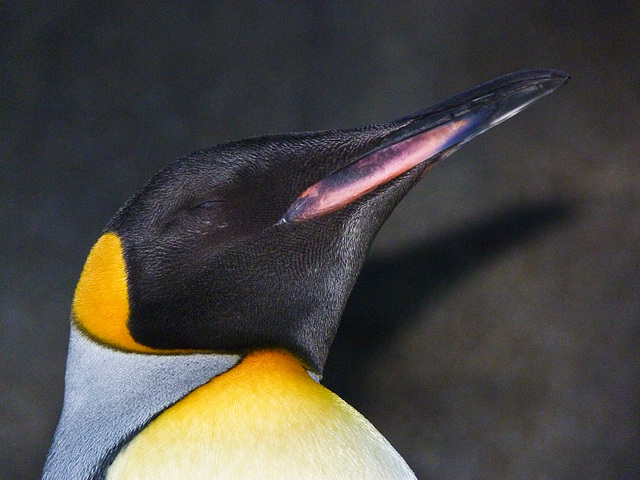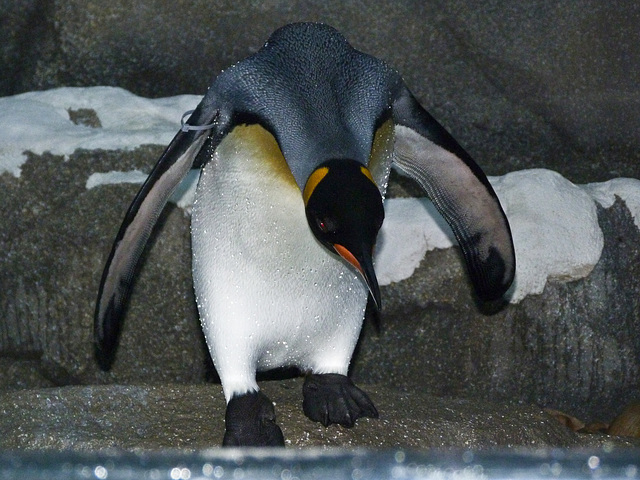
Penguins : )
"A waddle of penguins made their debut on 17 February 2012, as the Calgary Zoo opened its newest exhibit to the public. Penguin Plunge features 46 of the flightless birds in a $24.5-million complex located just inside the main entrance of the zoo. The new facility has four species of penguins: 10 Humboldts, 23 gentoos, eight kings and five rockhoppers. They came from five different zoos in east…
(read more)
They're here .... !!
Waited till yesterday to go to the Calgary Zoo, to see the new Penguin Plunge exhibit. I knew it was open to certain membership card owners between limited hours, but I chose to do other things with friends instead. Yesterday was the official opening day - and unfortunately it coincided with Professional Day holiday for many of the Calgary schools. The line-up was awful, and I almost changed my mind, but thankfully a friend happened to come down at the same time (and he almost turned around and left when he saw the length of the line) and so we passed the long wait chatting, which helped! The exhibit itself has been beautifully created - though very small. I suspect very long line-ups will continue for a long time, as these birds are going to be extremely popular. The four species of Penguin (46 Penguins in total) will stay indoors till spring and then just the Humboldt Penguins will have access to the outdoor area. I found the lighting inside was really bad for taking photos - the photo of King Penguins (not an endangered species) above was taken with flash, but still came out horribly. However, I'll take any photo of my first sight of a Penguin! Will add more detail when I get back at the end of the day, when I get home from a day out with some friends, going east of the city.
The Zoo now has four species of Penguin - Gentoo (23), King (8), Humboldt (10) and Rockhopper (5). They are part of the Association of Zoos and Aquariums penguin species survival plan.
The 46 penguins came from zoos in Quebec, Texas, New York and Washington states and Scotland. There are 8 King Penguins, 23 Gentoo Penguins, 10 Humboldt Penguins and 5 Rockhopper Penguins. The IUCN Red List states:
King Penguins - Least Concern
Humboldt Penguins - Vulnerable
Gentoo Penguins - Near Threatened
Rockhopper Penguins - Vulnerable
"The King Penguin (Aptenodytes patagonicus) is the second largest species of penguin at about 11 to 16 kg (24 to 35 lb), second only to the Emperor Penguin. There are two subspecies—A. p. patagonicus and A. p. halli; patagonicus is found in the South Atlantic and halli elsewhere.
King Penguins eat small fish, mainly lanternfish, and squid and rely less than most Southern Ocean predators on krill and other crustaceans. On foraging trips they repeatedly dive to over 100 metres (330 ft), often over 200 metres (660 ft).
King Penguins breed on the subantarctic islands at the northern reaches of Antarctica, South Georgia, and other temperate islands of the region. The total population is estimated to be 2.23 million pairs and is increasing."
storage.canoe.ca/v1/suns-prod-images/file/1297237247336_C...
en.wikipedia.org/wiki/King_Penguin
Rockhopper Penguin / Eudyptes chrysocome
Can we pretend that I added a layer of texture to this image, ha? I just had to post it, even though the quality is about as bad as it could be! This is a Rockhopper Penguin (Vulnerable Status), seen on February 17th at the Calgary Zoo's new exhibit, Penguin Plunge. Waited till then to go to the Calgary Zoo, to see the new exhibit. I knew it was open to certain membership card owners between limited hours for a sneak preview, but I chose to do other things with friends instead. Friday was the official opening day - and unfortunately it coincided with Professional Day holiday for many of the Calgary schools. The line-up was awful, and I almost changed my mind, but thankfully a friend happened to come down at the same time (and he almost turned around and left when he saw the length of the line) and so we passed the long wait chatting, which helped! The exhibit itself has been beautifully created - though very small. I suspect very long line-ups will continue for a long time, as these birds are going to be extremely popular. The four species of Penguin (46 Penguins in total) will stay indoors till spring and then will move to the outdoor area. I found the lighting inside was really bad for taking photos - the photo above was taken with flash, but still came out horribly. However, I'll take any photo of my first sight of a Penguin! Will add more detail when I get back home.
The Zoo now has four species of Penguin - Gentoo, King, Humboldt and Rockhopper. They are part of the Association of Zoos and Aquariums penguin species survival plan.
The 46 penguins came from zoos in Quebec, Texas, New York and Washington states and Scotland. There are 8 King Penguins, 23 Gentoo Penguins, 10 Humboldt Penguins and 5 Rockhopper Penguins. The IUCN Red List states:
King Penguins - Least Concern
Humboldt Penguins - Vulnerable
Gentoo Penguins - Near Threatened
Rockhopper Penguins - Vulnerable
"The King Penguin (Aptenodytes patagonicus) is the second largest species of penguin at about 11 to 16 kg (24 to 35 lb), second only to the Emperor Penguin. There are two subspecies—A. p. patagonicus and A. p. halli; patagonicus is found in the South Atlantic and halli elsewhere.
King Penguins eat small fish, mainly lanternfish, and squid and rely less than most Southern Ocean predators on krill and other crustaceans. On foraging trips they repeatedly dive to over 100 metres (330 ft), often over 200 metres (660 ft).
King Penguins breed on the subantarctic islands at the northern reaches of Antarctica, South Georgia, and other temperate islands of the region. The total population is estimated to be 2.23 million pairs and is increasing."
storage.canoe.ca/v1/suns-prod-images/file/1297237247336_C...
Gentoo Penguin - Near Threatened
This is about the only sharp photo I managed to take on February 17th, when I went to see the new Penguin Plunge exhibit at the Calgary Zoo, the lighting inside is so bad, with or without flash. More info when I get back home - have to drive part way across the city for the morning. Winter has returned yet again, so it's back to clearing the snow off my car before I can go anywhere.
Later: the sun came out and the sky turned blue and it's so beautiful out there right now. Much as I would love to go back out again, I have no choice but to stay home and back up some photo files to external hard drive, so that I can delete them from my hard drive. Almost completely out of space - again : )
en.wikipedia.org/wiki/Gentoo_Penguin
.
This is for Chantel and Ethan, who miss their Grandpa (Doug Waylett) so much! I didn't have a photo of a Tiger, Ethan - I know you have a little stuffed Tiger that your Grandpa bought you at the Zoo last summer - but I thought you both might just like to see one of our new Penguins. They are so beautiful and so much fun to watch. I know you miss your Grandpa so much - you were so lucky to have such a kind, patient, fun Grandpa. All his friends miss him a lot, too.
Has anyone else been unable to get on to Flickr this afternoon? I kept getting connection refused or connection timed out, etc., etc.. I finally got on just now, around 5:00 p.m.. Later: almost midnight and it's still taking forever to do each tiny thing on Flickr.
March of the Humboldt Penguins
One of the four species of Penguin in the new Penguin Plunge exhibit at the Calgary Zoo. Really bad light inside the exhibit, as far as taking photos is concerned : ( Will add a bit of info when I get back from a very cold walk all morning, in Fish Creek Park.
There are 10 Humboldt Penguins (Spheniscus humboldti) at the Zoo. The status of this species is IUCN Red List: Vulnerable. Current Impacts on their numbers are El Niño and La Niña weather patterns, predators, tourism, competition with fisheries, habitat change. Humboldt penguins groom their feathers before breakfast. They rub oil from a gland at the base of the tail into their feathers and the edges of their wings. Humboldts also groom each other. This species digs nesting burrows in thick deposits of seabird guano (poo)."
storage.canoe.ca/v1/suns-prod-images/file/1297237247336_C...
A quick preen
A Humboldt Penguin preening in the new Penguin Plunge exhibit at the Calgary Zoo. Taken on February 24th.
Elegance of the avian kind
One of the few photos that came out sharp enough from another visit to the new Penguin Plunge enxhibit at the Calgary Zoo. The Zoo has four species of Penguin - Gentoo, King, Humboldt, and Rockhopper. They are part of the Association of Zoos and Aquariums penguin species survival plan.
The 46 penguins came from zoos in Quebec, Texas, New York and Washington states and Scotland. There are 8 King Penguins, 23 Gentoo Penguins, 10 Humboldt Penguins and 5 Rockhopper Penguins. The IUCN Red List states:
King Penguins - Least Concern
Humboldt Penguins - Vulnerable
Gentoo Penguins - Near Threatened
Rockhopper Penguins - Vulnerable
"The King Penguin (Aptenodytes patagonicus) is the second largest species of penguin at about 11 to 16 kg (24 to 35 lb), second only to the Emperor Penguin. There are two subspecies—A. p. patagonicus and A. p. halli; patagonicus is found in the South Atlantic and halli elsewhere.
King Penguins eat small fish, mainly lanternfish, and squid and rely less than most Southern Ocean predators on krill and other crustaceans. On foraging trips they repeatedly dive to over 100 metres (330 ft), often over 200 metres (660 ft).
King Penguins breed on the subantarctic islands at the northern reaches of Antarctica, South Georgia, and other temperate islands of the region. The total population is estimated to be 2.23 million pairs and is increasing."
storage.canoe.ca/v1/suns-prod-images/file/1297237247336_C...
en.wikipedia.org/wiki/King_Penguin
Link to article about fossilised giant penguin bones which lived 27-24 million years ago:
www.thestar.com/news/world/article/1138465--giant-penguin...
About to take the plunge
One of the King Penguins at the new Penguin Plunge exhibit at the Calgary Zoo, taken yesterday on a not very fruitful visit : ) All the King Penguins were swimming most of the time. Also wasn't able to get to the front of the crowd of people for more than a moment or two. Each time is different - can't wait for later on, when there are no line-ups and no limit of 15 minutes.
The Calgary Zoo does not have a Penguin webcam, but below is a link to a Penguin webcam at Sea World San Diego’s Penguin Encounter exhibit, featuring nearly 300 penguins including five species, which are featured in the Discovery series. The epic seven-part series premieres on Discovery Channel on March 18 at 8pm ET/PT.
seaworldparks.com/en/seaworld-sandiego/Animals/Webcams/Pe...
Below is a link for a 4.5 min. video that a friend e-mailed me. Underwater footage shot whilst scuba diving in the Fiji islands and Tonga. Featuring colorful coral reefs, huge schools of tropical fish, sharks, humpback whales, underwater caves, scuba divers and much more marine life from the south Pacific. It is superbly filmed!
Dakuwaqa's Garden - Underwater footage from Fiji & Tonga.
youtu.be/mcbHKAWIk3I
Humboldt Penguin
This is one of the four species of Penguin in the new Penguin Plunge exhibit at the Calgary Zoo. Really bad light inside the exhibit, as far as taking photos is concerned : ( This is one of the very few photos that has come out sharp enough so far, so I'm only very slowly adding new photos to my Penguins set. This species is named after the cold water current it swims in, which is itself named after Alexander von Humboldt, an explorer.
There are 10 Humboldt Penguins (Spheniscus humboldti) at the Zoo. The status of this species is IUCN Red List: Vulnerable. Current Impacts on their numbers are El Niño and La Niña weather patterns, predators, tourism, competition with fisheries, habitat change. Humboldt penguins groom their feathers before breakfast. They rub oil from a gland at the base of the tail into their feathers and the edges of their wings. Humboldts also groom each other. This species digs nesting burrows in thick deposits of seabird guano (poo)."
storage.canoe.ca/v1/suns-prod-images/file/1297237247336_C...
"The current status of this penguin is threatened, due to a declining population caused in part by over-fishing, climate change, and ocean acidification. Historically it was the victim of guano over-exploitation. Penguins are also declining in numbers due to habitat destruction."
en.wikipedia.org/wiki/Humboldt_Penguin
Jump to top
RSS feed- Latest items - Subscribe to the latest items added to this album
- ipernity © 2007-2025
- Help & Contact
|
Club news
|
About ipernity
|
History |
ipernity Club & Prices |
Guide of good conduct
Donate | Group guidelines | Privacy policy | Terms of use | Statutes | In memoria -
Facebook
Twitter

